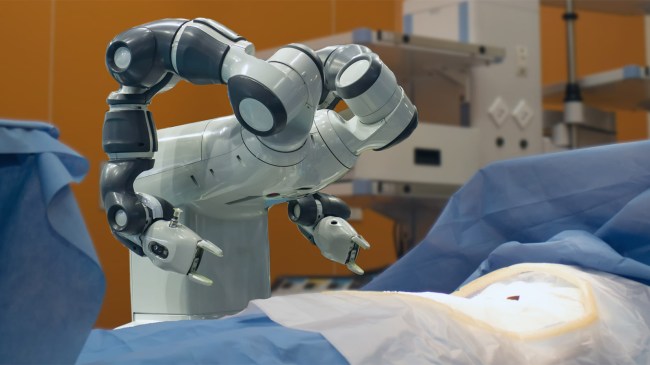
Audio By Carbonatix
In a world first, an AI-powered robot performed delicate surgery without any assistance from human hands. The robot learned how to do the operation by watching videos of it being done by humans. It then autonomously performed the surgery by listening and responding to voice commands.
The robot went 8-for-8
The surgical robot, named SRT-H, was able to successfully remove gallbladders (what is known as a cholecystectomy) from pig cadavers in eight different procedures. It succeeded with 100% accuracy in each procedure with no hands-on human intervention, according to the researchers in a report published in the journal Science Robotics. The researchers involved in the study called it “a milestone toward clinical deployment of autonomous surgical systems.”
A cholecystectomy is one of the most common surgical procedures in the world with several hundred thousand of them performed each year in the United States. The gallbladder removal procedure is made up of a string of 17 tasks. Those include identifying certain ducts and arteries, gripping them precisely, strategically placing clips, and then severing parts with surgical scissors.
“We were able to perform a surgical procedure with a really high level of autonomy,” Axel Krieger, assistant professor of mechanical engineering at Johns Hopkins, told the Guardian. “What we’ve done here is really a full procedure.”
According to the researchers, robot SRT-H, “truly performs surgery, adapting to individual anatomical features in real-time, making decisions on the fly, and self-correcting when things don’t go as expected.” The robot does this by choosing its surgical strategies through a hierarchical policy which selects objectives then maps them to motor commands.
Much like a surgical resident
While the AI-powered robot did take longer than it would a human surgeon, study co-author surgeon Jeff Jopling from Johns Hopkins pointed out that the robot is really no different than surgical residents that “master different parts of an operation at different rates.” The robot was also able to successfully navigate changes from one procedure to the next. It successfully self-corrected an average of six times per procedure.
“This advancement moves us from robots that can execute specific surgical tasks to robots that truly understand surgical procedures,” Krieger said in a statement. “This is a critical distinction that brings us significantly closer to clinically viable autonomous surgical systems that can work in the messy, unpredictable reality of actual patient care.”
Krieger added, “To me it really shows that it’s possible to perform complex surgical procedures autonomously. This is a proof of concept that it’s possible and this imitation learning framework can automate such complex procedure with such a high degree of robustness.”
He says the next step on this path is to have a robot use this “imitation learning” to autonomously run trials on cadavers and eventually operate on a live animal. Perhaps someday, he hopes, robots in a rural clinic setting will be able to perform the same surgical procedures conducted at larger, urban facilities.